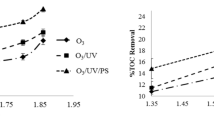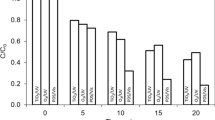Abstract
Advanced oxidation processes (AOPs) are an available solution for the rapid growth of the water pollution problem. In the present study, the process of UV-LED/WO3 and plasma was comparatively studied to remove reactive blue 19. The photocatalyst process efficiency was analyzed by statistical Taguchi model. The effect of experimental variables of contact time, pH, catalyst dosage, and pollutant dosage was investigated and found that the model is able to explain the process due to the high value of R > 95%, and the optimum condition was at 10 mg/L of dye concentration, 1g/L of catalyst, and 180 min of detention time in which over 75% of degradation was achieved. Based on the model, the more reaction time would increase the reactor performance, while further excessive increase of catalyst dosage over 1 g/L would deteriorate the performance. Obviously, the least amount of pollutant is the most favorable for the treatment reactor. Using plasma process for dye degradation was the next step of the research. Accordingly, the removal rate achieved over 90% of 10 mg/L of initial industrial dye in durational time of 4 min, input voltage 13.5 kV, and pH = 2. The results showed the higher oxidizing capacity of plasma than the conventional photocatalyst process.








Similar content being viewed by others
Data Availability
The datasets used and/or analyzed during the current study are available from the corresponding author on reasonable request.
Abbreviations
- R.B 19:
-
reactive blue 19
- CT:
-
contact time
- DC:
-
dye concentration
- CD:
-
catalyst dosage
- S/N:
-
sound to noise
- COD:
-
chemical oxygen demand
- TOC:
-
total organic carbon
References
Abbas Y, Lu W, Wang Q, Dai H, Liu Y, Fu X, Pan C, Ghaedi H, Cheng F, Wang H (2020) Remediation of pyrene contaminated soil by double dielectric barrier discharge plasma technology: performance optimization and evaluation. Environ Pollut 260:113944. https://doi.org/10.1016/j.envpol.2020.113944
Abdi J, Vossoughi M, Mahmoodi NM, Alemzadeh I (2017) Synthesis of metal-organic framework hybrid nanocomposites based on GO and CNT with high adsorption capacity for dye removal. Chem Eng J 326:1145–1158. https://doi.org/10.1016/j.cej.2017.06.054
Alkaykh S, Mbarek A, Ali-Shattle EE (2020a) Photocatalytic degradation of methylene blue dye in aqueous solution by MnTiO3 nanoparticles under sunlight irradiation. Heliyon 6(4):e03663
Alkaykh S, Mbarek A, Ali-Shattle EE (2020b) Photocatalytic degradation of methylene blue dye in aqueous solution by MnTiO3 nanoparticles under sunlight irradiation. Heliyon, 6(4)
Arimi A, Farhadian M, Solaimany Nazar AR, Homayoonfal M (2016) Assessment of operating parameters for photocatalytic degradation of a textile dye by Fe2O3/TiO2/clinoptilolite nanocatalyst using Taguchi experimental design. Res Chem Intermed 42(5):4021–4040
Bilal M, Rasheed T, Iqbal HM, Li C, Wang H, Hu H, Wang W, Zhang X (2018) Photocatalytic degradation, toxicological assessment and degradation pathway of CI reactive blue 19 dye. Chem Eng Res Des 129:384–390
Ding X, Gutierrez L, Croue J-P, Li M, Wang L, Wang Y (2020) Hydroxyl and sulfate radical-based oxidation of RhB dye in UV/H2O2 and UV/persulfate systems: kinetics, mechanisms, and comparison. Chemosphere 253:126655
Ebrahimpour Z, Pliekhova O, Cabrera H, Abdelhamid M, Korte D, Gadedjisso-Tossou KS, Niemela J, Stangar UL, Franko M (2021) Photodegradation mechanisms of reactive blue 19 dye under UV and simulated solar light irradiation. Spectrochim Acta A Mol Biomol Spectrosc 252:119481
Elmolla ES, Chaudhuri M (2010) Degradation of amoxicillin, ampicillin and cloxacillin antibiotics in aqueous solution by the UV/ZnO photocatalytic process. J Hazard Mater 173(1):445–449. https://doi.org/10.1016/j.jhazmat.2009.08.104
Ghalebizade M, Ayati B (2020) Investigating electrode arrangement and anode role on dye removal efficiency of electro-peroxone as an environmental friendly technology. Sep Purif Technol 251:117350. https://doi.org/10.1016/j.seppur.2020.117350
Gholizade A, Asadollahfardi G, Rezaei R (2023) Reactive blue 19 dye removal by UV-LED/chlorine advanced oxidation process. Environ Sci Pollut Res 30(1):1704–1718
Guo K, Wu Z, Yan S, Yao B, Song W, Hua Z, Zhang X, Kong X, Li X, Fang J (2018) Comparison of the UV/chlorine and UV/H2O2 processes in the degradation of PPCPs in simulated drinking water and wastewater: kinetics, radical mechanism and energy requirements. Water Res 147:184–194
Haddad FA, Moussavi G, Moradi M (2019) Advanced oxidation of formaldehyde in aqueous solution using the chemical-less UVC/VUV process: kinetics and mechanism evaluation. J Water Process Eng 27:120–125
Hoang NT-T, Tran AT-K, Hoang M-H, Nguyen TTH, Bui X-T (2021) Synergistic effect of TiO2 /chitosan/glycerol photocatalyst on color and COD removal from a dyeing and textile secondary effluent. Environ Technol Innov 21:101255. https://doi.org/10.1016/j.eti.2020.101255
Kumar K, Singh GK, Dastidar MG, Sreekrishnan TR (2014) Effect of mixed liquor volatile suspended solids (MLVSS) and hydraulic retention time (HRT) on the performance of activated sludge process during the biotreatment of real textile wastewater. Water Resour Indust 5:1–8. https://doi.org/10.1016/j.wri.2014.01.001
Laohaprapanon S, Matahum J, Tayo L, You S-J (2015) Photodegradation of reactive black 5 in a ZnO/UV slurry membrane reactor. J Taiwan Inst Chem Eng 49:136–141. https://doi.org/10.1016/j.jtice.2014.11.017
Li H, Liu S, Zhao J, Feng N (2016) Removal of reactive dyes from wastewater assisted with kaolin clay by magnesium hydroxide coagulation process. Colloids Surf A Physicochem Eng Asp 494:222–227. https://doi.org/10.1016/j.colsurfa.2016.01.048
Meiyazhagan S, Yugeswaran S, Ananthapadmanabhan P, Suresh K (2020) Process and kinetics of dye degradation using microplasma and its feasibility in textile effluent detoxification. J Water Process Eng 37:101519
Moussavi G, Fathi E, Moradi M (2019) Advanced disinfecting and post-treating the biologically treated hospital wastewater in the UVC/H2O2 and VUV/H2O2 processes: performance comparison and detoxification efficiency. Process Saf Environ Prot 126:259–268
Ouzar A, Kim I-K (2022) Tetracycline degradation by nonthermal plasma: removal efficiency, degradation pathway, and toxicity evaluation. Water Sci Technol 86(11):2794–2807
Panda P, Mahanta RK, Mohanty S, Paikaray R, Das SP (2021) Abatement of gas-phase VOCs via dielectric barrier discharge plasmas. Environ Sci Pollut Res 28(22):28666–28679. https://doi.org/10.1007/s11356-021-12565-x
Rahimpour M, Taghvaei H, Zafarnak S, Rahimpour MR, Raeissi S (2019) Post-discharge DBD plasma treatment for degradation of organic dye in water: a comparison with different plasma operation methods. J Environ Chem Eng 7(4):103220. https://doi.org/10.1016/j.jece.2019.103220
Rani CN, Karthikeyan S (2020) Feasibility study of acenaphthene degradation in a novel slurry UV photocatalytic membrane reactor: effect of operating parameters and optimization using response surface modeling. Chem Eng Process Process Intensif 155:108051. https://doi.org/10.1016/j.cep.2020.108051
Samarghandi MR, Zarrabi M, Amrane A, Sepehr MN, Noroozi M, Namdari S, Zarei A (2012) Kinetic of degradation of two azo dyes from aqueous solutions by zero iron powder: determination of the optimal conditions. Desalin Water Treat 40(1-3):137–143
Sarangapani C, Dixit Y, Milosavljevic V, Bourke P, Sullivan C, Cullen P (2017) Optimization of atmospheric air plasma for degradation of organic dyes in wastewater. Water Sci Technol 75(1):207–219
Shafeei N, Asadollahfardi G, Moussavi G, Boojar MMA (2019) Degradation of ibuprofen in the photocatalytic process with doped TiO2 as catalyst and UVA-LED as existing source. Desalin Water Treat 142:341–352
Sugiarto AT, Ito S, Ohshima T, Sato M, Skalny JD (2003) Oxidative decoloration of dyes by pulsed discharge plasma in water. J Electrost 58(1):135–145. https://doi.org/10.1016/S0304-3886(02)00203-6
Sun Y, Hua X, Ge R, Guo A, Guo Z, Dong D, Sun W (2013) Investigation on pretreatment of centrifugal mother liquid produced in the production of polyvinyl chloride by air-Fenton technique. Environ Sci Pollut Res 20(8):5797–5805
Yang Q, Zhong Y, Zhong H, Li X, Du W, Li X, Chen R, Zeng G (2015) A novel pretreatment process of mature landfill leachate with ultrasonic activated persulfate: optimization using integrated Taguchi method and response surface methodology. Process Saf Environ Prot 98:268–275. https://doi.org/10.1016/j.psep.2015.08.009
Yazdanbakhsh A, Eslami A, Massoudinejad M, Avazpour M (2020) Enhanced degradation of sulfamethoxazole antibiotic from aqueous solution using Mn-WO3/LED photocatalytic process: kinetic, mechanism, degradation pathway and toxicity reduction. Chem Eng J 380:122497. https://doi.org/10.1016/j.cej.2019.122497
Yetilmezsoy K, Demirel S, Vanderbei RJ (2009) Response surface modeling of Pb (II) removal from aqueous solution by Pistacia vera L.: Box–Behnken experimental design. J Hazard Mater 171(1-3):551–562
Funding
Financial support of Kharazmi University.
Author information
Authors and Affiliations
Contributions
Negar Namjoo: investigation, methodology, and data curation. Mohammad Delnavaz: supervision, conceptualization, methodology, and writing. Sajad Mahdian: writing, review, and editing.
Corresponding author
Ethics declarations
Ethical approval
This is not applicable for my study.
Consent to participate
All authors give informed consent to participate in the study.
Consent for publication
All authors agreed with the content, and all gave explicit consent to publish their data on the paper submitted in the Journal of Environmental Science and Pollution Research.
Competing interests
The authors declare no competing interests.
Additional information
Responsible Editor: Sami Rtimi
Publisher’s note
Springer Nature remains neutral with regard to jurisdictional claims in published maps and institutional affiliations.
Rights and permissions
Springer Nature or its licensor (e.g. a society or other partner) holds exclusive rights to this article under a publishing agreement with the author(s) or other rightsholder(s); author self-archiving of the accepted manuscript version of this article is solely governed by the terms of such publishing agreement and applicable law.
About this article
Cite this article
Namjoo, N., Delnavaz, M. & Mahdian, S.S. Comparing removal of synthetic anthraquinone dye wastewater in an electrical discharge and UV-LED/WO3 reactors: using statistical Taguchi optimization approach. Environ Sci Pollut Res 30, 110539–110549 (2023). https://doi.org/10.1007/s11356-023-30147-x
Received:
Accepted:
Published:
Issue Date:
DOI: https://doi.org/10.1007/s11356-023-30147-x




